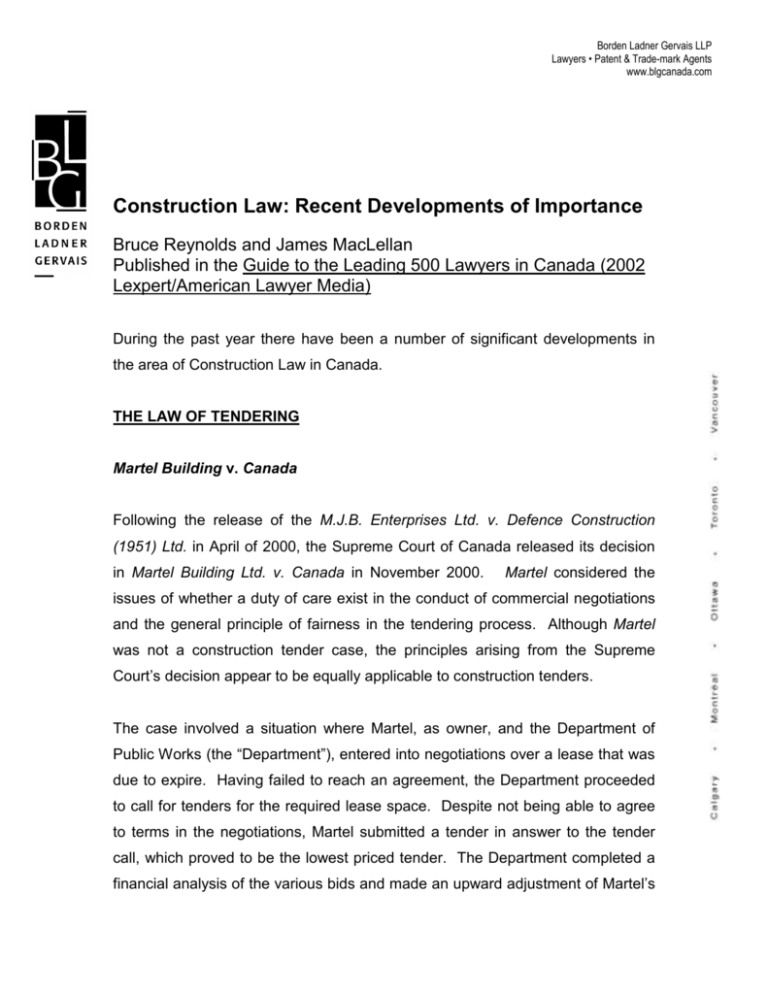Construction Law - Borden Ladner Gervais LLP
advertisement

Borden Ladner Gervais LLP Lawyers • Patent & Trade-mark Agents www.blgcanada.com Construction Law: Recent Developments of Importance Bruce Reynolds and James MacLellan Published in the Guide to the Leading 500 Lawyers in Canada (2002 Lexpert/American Lawyer Media) During the past year there have been a number of significant developments in the area of Construction Law in Canada. THE LAW OF TENDERING Martel Building v. Canada Following the release of the M.J.B. Enterprises Ltd. v. Defence Construction (1951) Ltd. in April of 2000, the Supreme Court of Canada released its decision in Martel Building Ltd. v. Canada in November 2000. Martel considered the issues of whether a duty of care exist in the conduct of commercial negotiations and the general principle of fairness in the tendering process. Although Martel was not a construction tender case, the principles arising from the Supreme Court’s decision appear to be equally applicable to construction tenders. The case involved a situation where Martel, as owner, and the Department of Public Works (the “Department”), entered into negotiations over a lease that was due to expire. Having failed to reach an agreement, the Department proceeded to call for tenders for the required lease space. Despite not being able to agree to terms in the negotiations, Martel submitted a tender in answer to the tender call, which proved to be the lowest priced tender. The Department completed a financial analysis of the various bids and made an upward adjustment of Martel’s Construction Law by B. Reynolds and J. MacLellan bid on account of various fit-up and related costs which resulted in Martel’s bid becoming the second lowest priced tender. The Department elected to enter into a lease agreement with another party which it viewed to be the lowest tender. Shortly thereafter, Martel commenced an action against the Department for recovery of its damages. The case came to the Supreme Court by way of an appeal by the Department of the decision of the Federal Court of Appeal finding the Department liable to Martel. The Supreme Court allowed the appeal and set aside the judgment of the Federal Court of Appeal which it found to have erred in allowing Martel’s claim. The appeal to the Supreme Court raised the following two issues of importance to construction law practitioners: 1. Does a duty of care exist in the conduct of commercial negotiations? 2. Did the Federal Court of Appeal err in finding that the Department owed Martel a duty of care in the tendering process and that this duty was breached? On the first issue, the Supreme Court concluded that no duty of care arises in conducting commercial negotiations. On the second and more relevant issue pertaining to tendering, the Supreme Court held, following the analysis in Ron Engineering and M.J.B. Enterprises, as follows: “We believe that implying a term to be fair and consistent in the assessment of the tender bids is justified based on the presumed intention of the parties. Such implication is necessary to give business efficacy to the tendering process…we find it difficult to believe that the respondent in this case, or any of the other three tenderers, would have submitted a bid Borden Ladner Gervais LLP Lawyers • Patent & Trade-mark Agents www.blgcanada.com 2 Construction Law by B. Reynolds and J. MacLellan unless it was understood by those involved that all bidders would be treated fairly and equally…Implying an obligation to treat all bidders fairly and equally is consistent with the goal of protecting and promoting the integrity of the bidding process, and benefits all participants involved. Without this implied term, tenderers, whose fate could be predetermined by some undisclosed standards, would either incur significant expenses in preparing futile bids or ultimately avoid participating in the tender process. and, perhaps most importantly for construction law practitioners, the Supreme Court stated: “A privilege clause reserving the right not to accept the lowest or any bids does not exclude the obligation to treat all bidders fairly. Nevertheless, the tender documents must be examined closely to determine the full extent of the obligation of fair and equal treatment. In order to respect the parties’ intentions and reasonable expectations, such a duty must be defined with due consideration to the express contractual terms of the tender. A tendering authority has “the right to include stipulations and restrictions and to reserve privileges to itself in the tender documents.” The Supreme Court’s preliminary and undisputed finding was that “Contract A” (as defined in R. v. Ron’s Engineering 1981, S.C.C.) had clearly come into existence Also of note, is the Supreme Court’s use of the terms “fair and consistent” and “fairly and equally” in describing the owner’s obligations to bidders. It appears that in order to protect the integrity of the tendering system the Supreme Court has found that an owner must provide all bidders with consistent and equal treatment. Where an owner does not do so, it may be in breach of the terms of the tender and found liable to an unsuccessful tender for its breach. In summary, the Supreme Court has confirmed the principles of Borden Ladner Gervais LLP Lawyers • Patent & Trade-mark Agents www.blgcanada.com 3 Construction Law by B. Reynolds and J. MacLellan tender fairness which have been long understood in practice but not always recognized by lower Courts. Naylor Group v. Ellis-Don On September 27, 2001, the Supreme Court of Canada dismissed the appeal from the Ontario Court of Appeal in Naylor Group Inc. v. Ellis-Don Construction Ltd. without reasons. In its decision, the Ontario Court of Appeal held, among other things that the principles in R. v. Ron Engineering and Construction (Eastern) Ltd. 1981. S.C.C. applied as between a prime contractor and subcontractor and that a binding relationship was created upon the submission of a tender to a general contractor by a subcontractor. In Ron Engineering, the Supreme Court of Canada held that a preliminary, “Contract A” arises when a contractor submits a bid to an owner in response to a call for tenders. One of the terms of “Contract A” is that the contractor cannot withdraw its bid for a stipulated period of time after the bid has been opened. “Contract B” is created when the contractor and owner enter into the formal contract. In Naylor Group Inc. vs. Ellis-Don, Naylor submitted a bid to Ellis-Don for the electrical work on a hospital project in Oakville, Ontario. Ellis-Don, the prime contractor, carried the Naylor bid and was the successful prime contractor. Prior to the formal award of the prime contract, Ellis-Don receive a ruling from the Ontario Labour Relations Board (“OLRB”) regarding Ellis-Don’s right to contract with companies whose employees were not members of an International Brotherhood of Electrical Workers (“IBEW”) affiliated union. Although, Naylor’s employees were unionized, they were not affiliated with the IBEW. Following the release of the OLRB decision, Ellis-Don began a search for an IBEW affiliated electrical subcontractor. Upon the award of the prime contract, Ellis-Don did not enter into an electrical subcontract with Naylor but instead with another electrical subcontractor, at Naylor’s price. Naylor commenced an action against Ellis-Don Borden Ladner Gervais LLP Lawyers • Patent & Trade-mark Agents www.blgcanada.com 4 Construction Law by B. Reynolds and J. MacLellan for breach of the bid contract or, in the alternative, unjust enrichment The Court of Appeal considered the following issues on the appeal: 1. Was there a preliminary contract, or “Contract A”, between Naylor and Ellis-Don?; 2. Was Ellis-Don’s objection to using Naylor reasonable?; 3. Was Ellis-Don unjustly enriched by not entering into Contract “B” with Naylor?; and 4. What are Naylor’s damages? In respect of the first issue, the Court of Appeal held that “Contract A” came into being between Naylor and Ellis-Don upon submission of Naylor’s bid to Ellis-Don and upon Ellis-Don incorporating Naylor’s bid as part of its tender to the Owner. The Court of Appeal noted that Ellis-Don was not automatically required to enter into a construction contract with Naylor when Naylor’s tender was carried by Ellis-Don. However, once the Owner accepted Ellis-Don’s bid, Ellis-Don did have certain obligations towards Naylor under “Contract A.” The obligations included the requirement that Ellis-Don enter into “Contract B” with Naylor unless it had a “reasonable objection” to using Naylor. With respect to the second issue, the Court of Appeal considered whether EllisDon’s rejection of Naylor was reasonable based on the OLRB decision and concluded that based on the particular facts, Ellis-Don’s rejection of Naylor was not reasonable given Ellis Don’s conduct in dealing with Naylor following the release of the OLRB decision. The Court of Appeal also noted that “Contract A” was not frustrated by the OLRB. The Court of Appeal was not satisfied that EllisDon had discharged its obligations to Naylor. Borden Ladner Gervais LLP Lawyers • Patent & Trade-mark Agents www.blgcanada.com 5 Construction Law by B. Reynolds and J. MacLellan With respect to unjust enrichment, the Court of Appeal found that Ellis-Don was unjustly enriched at Naylor’s expense as a result of the benefit it received from Naylor’s bid. In considering the quantum of Naylor’s damages, the Court of Appeal held that Naylor was entitled to damages as a result of Ellis-Don’s breach of “Contract A”. The Court of Appeal assessed Naylor’s damages as its lost opportunity of entering into the contract with Ellis-Don, which was Naylor’s estimated profit of completing the contract less various contingencies estimated by the Court of Appeal which reduced the recovery by Naylor. The Naylor decision is yet another example of the Courts vigilance in upholding the sanctity of the tender process. In dismissing the appeal without comment, the Supreme Court choose not to revisit and comment on the principles first enunciated by it in Ron Engineering. However, given the Supreme Court’s recent decisions in M.J.B. and Martel it is not surprising that the Supreme Court dismissed the appeal without reasons. TRUST RIGHTS On September 27, 2001, the Supreme Court of Canada denied leave to appeal the decision of the New Brunswick Court of Appeal in Western Surety Company vs. National Bank. The New Brunswick Court of Appeal decision could impact on the application of trust rights on road and highway work in certain provinces in Canada. Frizzell Construction was a general contractor operating in the Province of New Brunswick and involved in road building contracts. Western Surety was the surety company for Frizzell Construction and National Bank was its banker. In November of 1994, National Bank appropriated approximately $1,000,000 from Borden Ladner Gervais LLP Lawyers • Patent & Trade-mark Agents www.blgcanada.com 6 Construction Law by B. Reynolds and J. MacLellan the bank account of Frizzell Construction to reduce Frizzell Construction’s indebtedness to the National Bank. This amount related to contract funds on highway projects in the province of New Brunswick. Shortly thereafter, Frizzell sought the protection of Company Creditors Arrangement Act (“CCAA”), which resulted in a number of Frizzell’s subcontractors and suppliers on the same highway projects not being paid. Western Surety having issued labour and material payment bonds (“L & M Bonds”)on the highway projects made payments to the claimants under the L & M Bonds and then commenced an action against the National Bank for recovery of the contract funds appropriated by the National Bank from Frizzell’s bank account. The relevant sections of the New Brunswick Mechanics Lien Act (the “Act”) are as follows: s.2 This Act does not apply in respect of a highway or any work done or cause to be done thereon by a municipality, or in respect of material furnished thereon. s.3 All sums received from a builder or contractor or a subcontractor on account of the contract price are and constitute a trust fund in the hands of the builder or contractor, or the subcontractor, as the case may be for the benefit of the proprietor , builder or contractor, subcontractor, Worker’s Compensation Board, workmen and persons who supply material on account of the contract… The Court of Appeal held that the application of s.2 of the Act extinguished the trust rights given by s.3 of the Act on highway projects. In arriving at its decision, the Court of Appeal distinguished the Supreme Court of Canada’s decision in Canadian Bank of Commerce v. McAvity & Sons Ltd. (1959). In McAvity, the Supreme Court considered provisions of the Ontario Mechanics’ Borden Ladner Gervais LLP Lawyers • Patent & Trade-mark Agents www.blgcanada.com 7 Construction Law by B. Reynolds and J. MacLellan Lien Act which were similar to those considered by the New Brunswick Court of Appeal. The section of the Ontario Mechanics’ Lien Act considered by the Supreme Court in McAvity was as follows: s.2 Nothing in this Act shall extend to any public street or highway or any work or improvement done or cause to be done by a municipal corporation thereon . The Supreme Court, in McAvity, held that the trust provisions in the Ontario Mechanics’ Lien Act did apply to highway projects notwithstanding s.2 and stated: As to s.2, when enacted in 1901, it was designed to prevent a lien, with a consequent right of sale, attaching upon a public street or highway for obvious reasons. No such reason could exist in the case of a new and distinct right given to material men and others in 1942. The language of s.2 is not designed to effect such a right and does not in my opinion include it. Further, in McAvity, the Supreme Court stated; The appellant however, contends that it is also effective to render s.3 inapplicable to monies received by a builder or contractor for work done on a street or highway. The language of s.2 is lacking in clarity. S.3 does not, by its terms, deal with public streets or highways but with money received by a builder or contractor on account of the contract price or work done, or material supplied and as the section reads, such money may be payable for work done for any of the purposes described in general terms by s.5. The language is sufficiently wide to cover work done upon a street or highway. To declare that money so received are to be held in trust, does not appear to me, on the face of it, to extend the section to a street or highway, even though monies from the particular case are payable in Borden Ladner Gervais LLP Lawyers • Patent & Trade-mark Agents www.blgcanada.com 8 Construction Law by B. Reynolds and J. MacLellan respect of the work done upon them. The appellant’s contentions seeks to construe this section as if it read that nothing in the Act should extent to any public street or highway, or to any money paid or payable in respect of the work on them. The Court of Appeal distinguished McAvity and held: Significantly, s.2 does more than make the Act inapplicable to a highway; it makes it inapplicable to certain work and material. Obviously, McAvity is distinguishable and can have no application here. The result of the Court of Appeal’s decision was that the National Bank was able to appropriate contract funds to the detriment of the suppliers of labour and material on the highway projects. As stated by the Supreme Court in McAvity, the purpose of s.2 type provisions is to prevent the registration of liens against public streets and highway and the possibility of a lien claimant being able to sell the highway to recover an unpaid account. The purpose of the trust provision is, of course, to keep the construction contract funds within the construction pyramid. The interpretation placed on s.2 by the New Brunswick Court of Appeal may enable creditors of contractors to intercept contract funds on highway projects and apply then to debts unrelated to the highway project. It remains to be seen whether any legislative change will be made to the New Brunswick Mechanics’ Lien Act to prevent this result. TRUST LIABILITY AND THE BANKRUPTCY AND INSOLVENCY ACT The Ontario Superior Court, in a recent decision held that the finding of liability against the principal of a construction company for breach of trust under Borden Ladner Gervais LLP Lawyers • Patent & Trade-mark Agents www.blgcanada.com 9 Construction Law by B. Reynolds and J. MacLellan s.13 of the Construction Lien Act fell within the exemption created by s.178 of the Bankruptcy and Insolvency Act (“BIA”), thereby preventing the principal, a bankrupt, from being discharged under the BIA for a breach of trust. In Re: Zumbo, two creditors obtained judgment against Zumbo, the principal of a construction company, for breach of the trust provisions of the Construction Lien Act. Zumbo made an assignment into bankruptcy. The two creditors opposed the discharge of Zumbo from bankruptcy on the basis that the claim for breach of trust under the Construction Lien Act against Zumbo was exempt from discharge under s.178 of the BIA. In Ontario, s.8 of the Construction Lien Act creates a trust for all amounts received by a contractor or a subcontractor on account of the contract or subcontract price of an improvement S.13 of the Construction Lien Act imposes liability on the officers and directors of a construction company for a breach of trust. S.178 (1) (d) of the BIA reads as follows: S.178(1) an order of discharge does not release the bankrupt from: (d) any debt or liability arising out of fraud, embezzlement, misappropriation or defalcation while acting in a fiduciary capacity; In considering whether the breach of trust would survive the discharge, the Court examined the conduct of Zumbo in the proceeding and in his construction business and noted as follows: i) Zumbo was an experienced contractor of many years; ii) Zumbo was aware of the provisions of the Construction Lien Act; Borden Ladner Gervais LLP Lawyers • Patent & Trade-mark Agents www.blgcanada.com 10 Construction Law by B. Reynolds and J. MacLellan iii) Zumbo ignored the provisions of the Construction Lien Act, keeping no books or records, thereby preventing anyone from tracing the money he received on projects. iv) Zumbo was aware of his obligations as trustee of the monies given to him for work done on projects and was aware that he was not applying the monies to persons or companies who had supplied services or goods for the project. v) In the bankruptcy proceedings, Zumbo failed to comply with orders requiring him to provide an accountings of the funds and failed to provide answers to undertakings as required. The Court concluded that based on Zumbo’s conduct and the finding of breach of trust, the claims against Zumbo fell within the exemption provided by s.178 of the BIA. Accordingly, the claims of the creditors survived the bankruptcy . While the Courts continue to restrict the type of payments which can be made by contractors from trust funds, they have expanded the consequences resulting from a finding of a breach of trust under the Construction Lien Act. Prudent contractors must be more diligent than ever in their accounting practices to avoid a finding of breach of trust. Borden Ladner Gervais LLP Lawyers • Patent & Trade-mark Agents www.blgcanada.com 11







